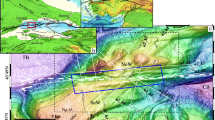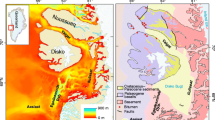Abstract
Interpretation of acoustic seismic records have allowed mapping of shallow gas accumulations and gas escape features in the Rías Baixas. X-ray photographs and voids of cores are semi-direct evidence of gassy sediments. Mapping of fluid-escape areas shows that these are related to the gas accumulations or at the intersections of faults. Analyses (GC-MS) of bubble samples collected in Simón Bay (Ría de Vigo) and across the whole ría confirm the presence of methane. The spatial distribution of gas escapes/accumulations and their vertical variations are interpreted as evidence of sedimentary facies control. The appearance of authigenic minerals (gypsum, pyrite and aragonite) and microbiological activity related to the seal facies are taken as evidence of the biogeochemical coupling processes. It is evident that these shallow-water coastal environments make significant contributions to the methane budget of the hydrosphere and atmosphere. It is also suggested that microbiological activity is favoured by gas escapes.













Similar content being viewed by others
References
Baraza J, Ercilla G, Nelson CH (1999) Potential geological hazards on the eastern gulf of Cádiz slope (SW Spain). Mar Geol 155:191–215
Berner RA (1975) Diagenetic models of dissolved species in the interstitial waters of compacting sediments. Am J Sci 275:88–96
Bussman I, Suess E (1998) Groundwater seepage in Eckernforde Bay (Western Baltic Sea): effects on methane and salinity distribution in the water column. Continent Shelf Res 18:1795–1806
Chappell J, Shackelton NJ (1986) Oxygen isotopes and sea level. Nature 324:137–140
Chappell J, Omura A, Esat T, McCulloch M, Pandolfi J, Ota Y, Pillans B (1996) Reconciliation of late Quaternary sea levels derived from coral terraces at Huon Peninsula with deep sea oxygen isotope records. Earth Planet Sci Lett 141:227–236
Claypool GE, Kaplan IR (1974) The origin and distribution of methane in marine sediments. In: Kaplan IR (ed) Natural gases in marine sediments. Plenum Press, London, pp 99–140
Dimitrov, LI (2002) Contribution to atmospheric methane by natural seepages on the Bulgarian continental shelf. Continent Shelf Res 25(16):2429–2442
ENIEPSA (1984) Sondeo Pontevedra Marino B-1. Dirección General de la Energía, Ministerio Industria, Comercio y Turismo, España
Ferrín A, Durán R, Diez R, García-Gil S, Vilas F (2003) Shallow gas features in the Galician Rías Baixas (NW Spain).Geo Mar Lett (23 3/4) (http://dx.doi.org/10.1007/s00367-003-0158-6)
Fleischer P, Orsi TH, Richardson MD, Anderson AL (2001) Distribution of free gas in marine sediments: a global overview. Geo Mar Lett 21:103–122
García-Díez T (2001) Pautas de Organización Geoquímica entre Sedimentos Carbonatados y Siliciclásticos en la Ría de Vigo: Comportamiento Superficial y Diagenético. MSc Thesis, Dept Geociencias Marinas y O.T., Facultad de Ciencias, Universidad de Vigo
García-García A (1999) Estudio del Gas de los Sedimentos de la Ría de Vigo Mediante Técnicas Sísmico-Acústicas de Alta Resolución. MSc Thesis, Dept Geociencias Marinas y O.T., Facultad de Ciencias, Universidad de Vigo
García-Gil S, Vilas-Martín F, Muñoz A, Acosta J, Uchupi E (1999a) Quaternary sedimentation and thermal diapirism in he Ría de Pontevedra (Galicia), northwest Spain. J Coast Res 15(4):1083–1090
García-Gil S, Vilas F, García-García A, Durán R (1999b) Holocene storm delta in incised-valley fill sediments of Ría de Pontevedra, NW Spain. Poster AGU Fall Meeting, San Francisco. Eos Trans 80(46):559
García-Gil S, García-García A, Vilas F (1999c) Identificación Sísmico-Acústica de las Diferentes Formas de Aparición de Gas en la Ría de Vigo (NO de España). Rev Soc Geol España 12(2):301–307
García-Gil S, Vilas F, García-García A, Durán R, Vilas F (2000) High-resolution seismic stratigraphy of the Rías Baixas: Pontevedra and Vigo (NW Spain). J Iberian Geol 26:217–231
García-Gil S, Croker P, Vilas F (2001) Seafloor mounds in the Muros and Arousa Rías of NW Spain. Poster-Abstracts Earth System Processes Global Meeting. Geological Society of America and Geological Society of London, Edinburgh
García-Gil S, Vilas F, García-García A (2002) Shallow gas features in incised-valley fills (Ría de Vigo, NW Spain): a case study. Continent Shelf Res 22(16):2303–2315
García-Gil S, García-Díez T, Fernandez-Bastero, Gago-Duport, Vilas F (2003) Early diagenetic reaction pathways between shallow gas and sediments: the Ría de Vigo (NW of Spain). Geophys Res Abstr 5:13747
Hagen RA, Vogt PR (1999) Seasonal variability of shallow biogenic gas in Chesapeake Bay. Mar Geol 158:75–88
Haq BU (1991) Sequence stratigraphy, sea-level, and significance for the deep sea. In: Macdonald DIM (ed) Sedimentation, tectonics and eustasy. Int Assoc Sedimentol Spec Publ 12:3–41
Hasiotis T, Papatheodorou G, Kastanos N, Ferentinos G (1996) A pockmark field in the Patras Gulf (Greece) and its activation during the 14/7/93 seismic event. Mar Geol 130:333–344
Hornafius JS, Quigley D, Luyendyk BP (1999) The world’s most spectacular marine hydrocarbon seeps (Coal oil point, Santa Barbara Channel, California): quantification of emissions. J Geophys Res 104(20):703–711
Hovland M (1984) Gas-induced erosion features in the North Sea. Earth Surface Process Landforms 9:209–228
Hovland M, Judd AG (1988): Seabed pockmarks and seepages: impact on geology, biology and the marine environment. Graham and Trotman, London
Hovland M, Judd AG (1992) The global production of methane from shallow submarine sources. Continent Shelf Res 12(10):1231–1238
Hovland M, Thomsen E (1997) Cold water corals: are they hydrocarbon seep related?. Mar Geol 137(1/2):159–164
Judd AG (2001) A review of pockmarks in the UK sector of the North Sea. Technical report produced for Strategic Environmental Assessment, TR_002, Department of Trade and Industry
Judd AG, Davies G, Wilson J, Holmes R, Baron G, Bryden I (1997) Contributions to atmospheric methane by natural seepages on the UK continental shelf. Mar Geol 140:427–455
Judd AG, Hovland M, Dimitrov LI, García-Gil S, Jukes V (2002) The geological methane budget at continental margins and its influence on climate change. Geofluids 2:109–126
Kaluzza MJ, Doyle EH (1996) Detecting fluid migration in shallow sediments: continental slope environment, Gulf of México. Hydrocarbon migration and its near-surface expression. Am Assoc Petrol Geol Mem 66:15–26
King LH, McLean B (1970) Pockmarks on the Scotian Shelf. Bull Geol Soc Am 81:3141–4148
Malone MJ, Claypool G, Martin JB, Dickens GR (2002) Variable methane fluxes in shallow marine systems over geologic time. The composition and origin of pore waters and authigenic carbonates on the New Jersey shelf. Mar Geol 189:175–196
Martens CS, Berner RA (1974) Methane production in the interstitial waters of sulfate-depleted marine sediments. Science 185:1167–1169
Martens CS, Albert DB, Alperin MJ (1998) Biogeochemical processes controlling methane in gassy coastal sediments. Part 1: a model coupling organic matter flux to gas production, oxidation, and transport. Continent Shelf Res 18:1741–1770
McQuaid J, Mercer A (1990) Air pressure and methane fluxes. Nature 351:528
Mijón O (1998) Antozoos de la Ría de Vigo. MSc Thesis, Dept de Ecología y Biología Animal, Facultad de Ciencias, Universidad de Vigo
Nonn H (1969) Évolution géomorphologique et types de relief en Galicia occidentale et septentrionale. Rev Geogr Phys Géol Dyn 9(2):31–50
Pannekoek AJ (1966) The ría problem: Tijdschr. Kon Ned Aardr Gen 83:289–297
Pannekoek AJ (1970) Pleistocene history of the Ría de Arousa. Leid Geol Meded 37:174–176
Pazos O, Nombela M, Alejo I, García-Gil S, Rubio B, García-Gil E, Vilas F (1995) La costa de Rías: Reunión sobre el Cambio de la Costa: los sistemas de rías. Comisión de Estratigrafía de la Sociedad Geológica de España
Ramil F, Ansín-Agís J, Fernández-Pulpeiro E (1998) Soft-bottom hydroids (Cnidaria: Hydrozoa) collected in the Ría de Vigo (NW Spain) Commemorative volume for the 80th birth day of Willem Vervoot in 1997. Zool Verh Leiden 323:182–208
Ríos AF, Pérez FF, Fraga F (1992) Water masses in upper and middle North Atlantic ocean east of Azores. Deep Sea Res 39:645–658
Vilas F, Nombela MA, García-Gil E, García-Gil S, Alejo I, Rubio B, Pazos O (1995) Cartografía de sedimentos submarinos, Ría de Vigo. E: 1:5,000. Ed. Xunta de Galicia, Conselleria de Pesca, Marisqueo e Acuicultura, Santiago de Compostela
Vilas F, García-Gil E, García-Gil S, Nombela MA, Alejo I, Rubio B, Pazos O (1996) Cartografía de sedimentos submarinos, Ría de Pontevedra. E: 1:5,000. Ed. Xunta de Galicia, Conselleria de Pesca, Marisqueo e Acuicultura, Santiago de Compostela
Vilas F, Nombela MA, García-Gil E, García-Gil S, Alejo I, Rubio B, Pazos O (1999) Cartografía de sedimentos submarinos. La Ría de Arosa. Escala 1:50,000 (Memoria y Mapa). Ed. Xunta de Galicia, Conselleria de Pesca, Marisqueo e Acuicultura, Santiago de Compostela
Wever TF, Abegg F, Fiedler HM, Fechner G, Stender IH (1998) Shallow gas in the muddy sediments of Eckernförde Bay, Germany. Continent Shelf Res 18(14–15):1715–1739
Acknowledgements
This paper presents updated gas research for the project PGIDT00PXI30105PR. It is also a contribution to REN2000-1102 MAR and, partially, to PGIDT00MAR30103PR, BTE2000-0877 and 464 IGCP projects. Special thanks to José Nogueiras and Sandra Rellán, from the Dept. of Química Analítica y Alimentaria, for helping with the gas chromatography analysis. Thanks also to Jorge Iglesias, Montserrat Martínez and Sandra Rúa for assistance with gas sampling. Special thanks to Dr Bilal Haq, Alan Judd and Vanny Aloisi for their comments that have greatly improved this paper.
Author information
Authors and Affiliations
Corresponding author
Rights and permissions
About this article
Cite this article
Garcia-Gil, S. A natural laboratory for shallow gas: the Rías Baixas (NW Spain). Geo-Mar Lett 23, 215–229 (2003). https://doi.org/10.1007/s00367-003-0159-5
Received:
Accepted:
Published:
Issue Date:
DOI: https://doi.org/10.1007/s00367-003-0159-5




